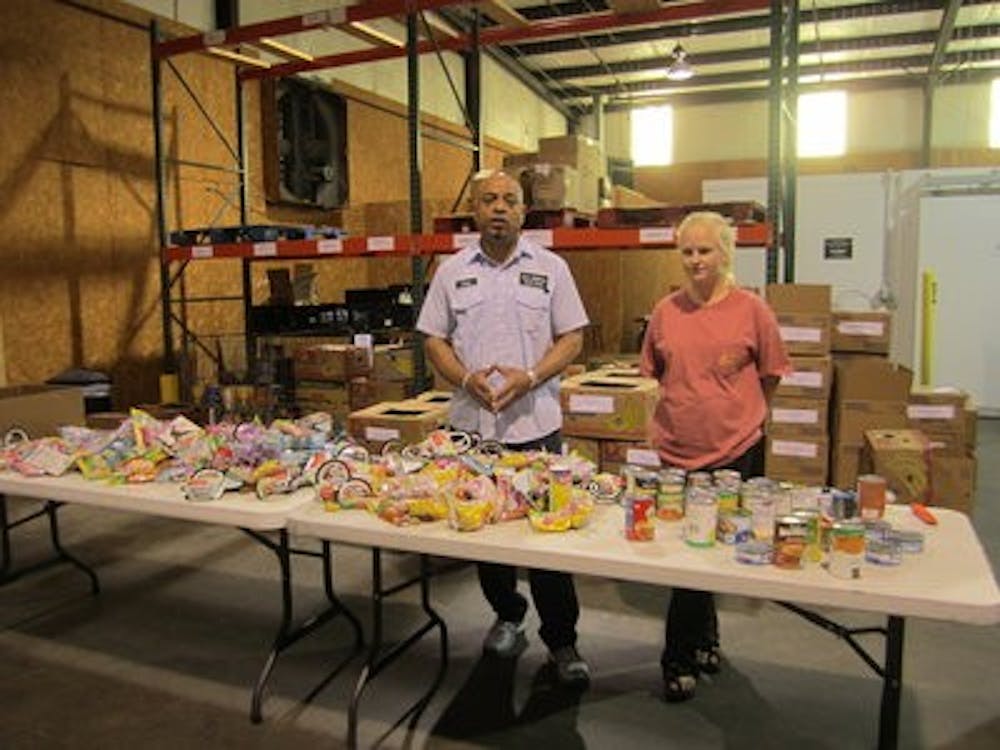A 15-minute drive from Auburn's campus is the Food Bank of East Alabama.
According to Feeding America, in 2011, 49 million people, who is more than 15 percent of the population, lived in poverty. Fifty million Americans lived in food insecure households, with 33.5 million being adults and 16.7 million being children.
According to the FBEA, in America, one in six adults and one in four children deal with hunger and food insecurity everyday. Food insecurity means people are unsure of where their next meal comes from or lacks the access to adequate nutrition.
The food bank's work is to resolve that issue by collecting and distributing food to agencies in contact with those in need.
Martha Henk has heroically led the FBEA for the last 18 years. Her daily 6 a.m. routine can be compared to missionary work.
She works with 190 agencies and oversees the distribution of approximately 5 million pounds of food. They average approximately 360,000 pounds per month, which is the equivalent of 14 fully loaded 18-wheelers.
"My food bank basically is involved with feeding people," Henk said. "Our job is to gather together the best supply of food that we can - donated food - and then make that available to churches and nonprofit organizations that have some kind of outreach. We help to supply them with food."
FBEA warehouse consists of 20,000 square feet with three loading docks, a salvage and repackaging center and a shopping area. The 25,000 cubic feet refrigerator houses perishables such as mangos and peppers.
It operates with four trucks and a van for deliveries.
"A lot of times people come in and they walk into the warehouse in the back and they see it's not just a few can goods sitting on a shelf," Henk said. "They have this picture that it's a food pantry where needy people come in, they pick a few little cans and then they leave and not realize it is actually much larger than that."
Henk said more than 60 percent of their agencies rely on the Food Bank of East Alabama for 100 percent of their food supply.
The Food Bank is stocked by local grocery stores such as Kroger, Winn-Dixie and Publix; food and financial donations, food drives like Beat Bama and surpluses from restaurants such as Panera Bread. The "best buy," "best sold by" and "best used by" dates on boxes force establishments to discard their food. In reality, it is still edible and may be donated to the Food Bank.
"[We] get product that is close to its 'use-by date' - it's usually perishable food - and then we bring it back here and sort it, organize it and get it out as quickly as we can," Henk said.
Henk lends the success of FBEA to the staff. They work with 27 people with 20-30 volunteers.
"Most of us are strongly motivated by the idea that we want to make a difference and we want to help people," Henk said.
Tony Laney, salvage director, begins the food processing. The salvage department ensures that food is fit for consumption. He organizes and inspects each donation. He works with the volunteers to box all foods for storage. After the food is inspected it is separated into different categories. Then, the food is put into boxes and recorded.
"We check for expiration dates, check for leakages, make sure there is not damage to the product and then we'll put it in a case," Laney said. "The case is then put on a palate. After we have a full palate of a product, then it's recorded and we take it to the back of the warehouse and it's slotted. Once it's slotted, at the end of the day, it's recorded onto our hard drive and customers can go check our food list online, and they can order the product from there."
Each case's content is gauged by weight, and weights vary by product. Laney said on a slow day he packages approximately 60,000 pounds of food.
"Our hands touch everything that's donated," Laney said.
Food that doesn't pass is taken to the compost. The Food Bank stays true that nothing should ever go to waste.
Kevin Thomas, distribution manager, is the next step. He packages and distributes each order and is the last stop before the truck.
Thomas's area comprises six rows, three-tiers high of cases and pallets. This area is the main source of noise in the warehouse. At any moment a machine is sorting, stacking or loading a delivery.
"The main thing we do is get the food out to the people," Thomas said. "Everyday we come in and we're pretty much pulling orders for that day and the next day and the rest of the week."
Thomas keeps everything tidy and follows strict regulations for stocking. Thomas interacts with the customers firsthand. He said meat and bread are always highest in demand.\0x2028 His favorite part is customer interaction. He said he makes a point to get to know everyone that comes through.\0x2028The food bank is a facet of Feeding America, a national organization founded in 1967 by John van Hengel.
When van Hengel struck up a conversation with a mother of seven living on the streets of Phoenix, Ariz., he was inspired to create the first food bank. In more than 50 years, it has grown to more than 200 food banks across the United States.
FBEA is one of eight in the Alabama Food Bank Association. Altogether, the state's food banks deliver more than 30 million pounds of food per year to those in need. FBEA services the populations of east and central Alabama.
After the food is loaded on to the trucks, it is taken to 190 churches, nonprofits and markets around eastern Alabama to be distributed to the food insecure. Henk said the level of need has only risen in the last few years due to hard economic times, but remains faithful that one day food insecurity could be cured.
Do you like this story? The Plainsman doesn't accept money from tuition or student fees, and we don't charge a subscription fee. But you can donate to support The Plainsman.





